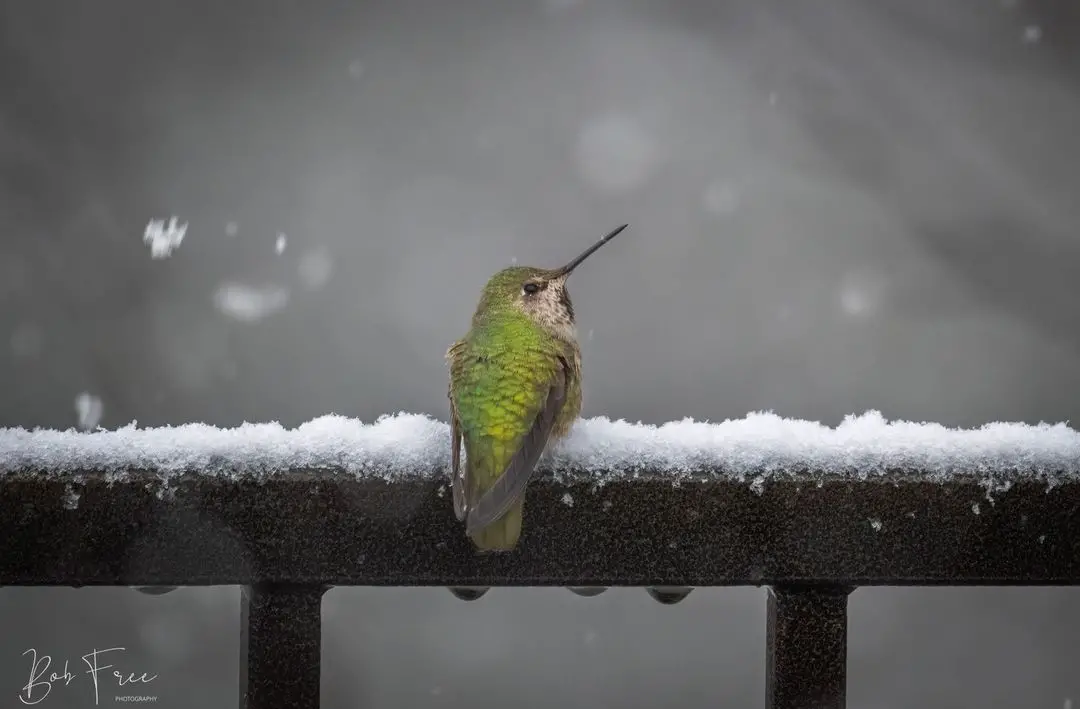This post contains affiliate links.
I was watching Anna’s hummingbirds return to overwinter in my area along the coast in southern California and was thinking about hummingbirds that choose to overwinter in colder climates, especially where it snows.
There are now many reported sightings of hummingbirds in snow and below-freezing temperatures visiting hummingbird feeders in the middle of the winter.
This article explains how a hummingbird enthusiast can help a hummingbird successfully survive in cold weather.
How to help hummingbirds in cold weather?
How to help hummingbirds in cold weather:
- Provide protected, warm areas for the hummingbirds to rest and sleep.
- Provide fresh, unfrozen sugar water from sunrise to sunset.
- Provide protein for hummingbirds to eat.
- Provide winter-blooming nectar-producing flowering plants for natural nectar.
At What Temperature Does Sugar Water Freeze?
The standard suggested hummingbird solution of 1:4 ratio of sugar to water starts to freeze around 26-27°F unlike pure water, which freezes at 32°F. The amount of sugar in the water affects the exact freezing point.
As frigid weather approaches, the curiosity of the freezing point of sugar water solution in your hummingbird feeder is a viable question.
If the nectar is frozen, the hummingbirds will not be able to access the vital and necessary nutrients they need to keep themselves warm during the winter months.
Scientific data states that pure water freezes at 32 degrees Fahrenheit, or 0 degrees Celsius.
A standard mixture of one part sugar to four parts water starts freezing around 26-27 degrees Fahrenheit (-3.33 degrees to -2.78 degrees Celsius).
The specific amount of sugar in the water affects the exact freezing point. The freezing point will decrease as more sugar is dissolved in the water. If the ratio is changed, such as using one part sugar to three parts water as some suggest for winter feedings, the freezing point becomes even lower.
If you are worried about your glass feeders freezing and breaking, be aware that water freezes at 32 degrees Fahrenheit, but the addition of sugar lowers the freezing point. If ambient temperatures drop below the sugar water’s freezing point, it will freeze and possibly break your glass hummingbird feeder.
Yet, it is best to be mindful of the outside temperature if you are providing needed food for the hummingbirds during the winter months.
Let’s dive into a bit of science. Both regular water and sugar water have three forms: solid (ice), liquid, and gas (steam). These three states are called substances.
Density is the next thing to think about. It refers to how tightly packed something is compared to its volume. High density means something is compact and has more mass squeezed into a given volume, while low density means the opposite.
When substances freeze or boil, they hit a specific temperature at which they change phases. The freezing and boiling points depend on various factors, including pressure and anything dissolved in the liquid.
Keep in mind that this is a rough estimate, and the freezing point can vary based on factors like the specific type of sugar used, impurities in the water, and atmospheric pressure/altitude.
How Do You Keep Sugar Water From freezing?
Keep sugar water from freezing by:
- Hang the feeder in a sheltered location
- Bring the feeder in at night
- Keep nectar warm
- Attach a heater to the hummingbird feeder
- Lamps, shop lights
- Hand warmer
- Holiday lights
- Insulate feeder
- Rotate feeders
- Use snow baffle weather domes
- Feeder Maintenance
A wild phenomenon unfolds each cold winter season, with hummingbirds deciding to either migrate south for the winter or overwinter in their area.
Two hummingbirds in particular, the Anna’s and Rufous, are known to sometimes not migrate south for the winter, but instead stay, thrive, and brave the brutally cold winter season and food scarcity even in the northern states.
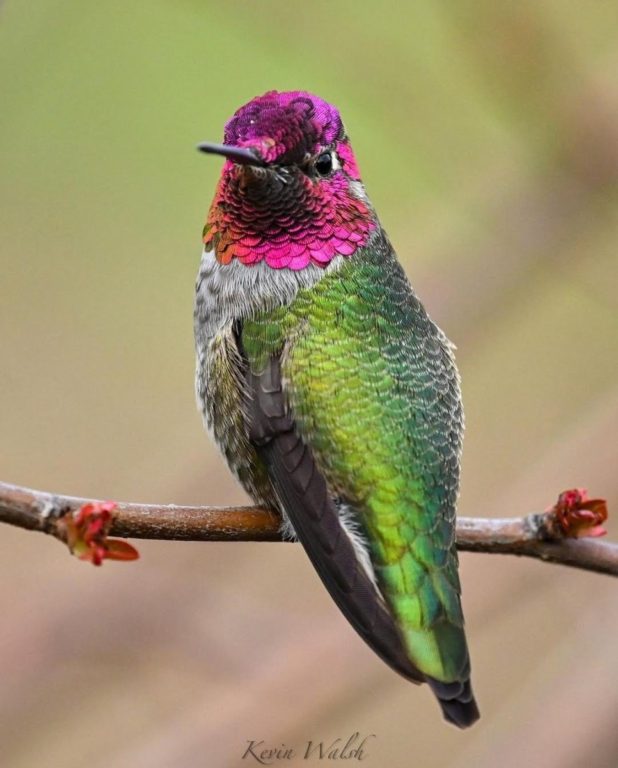
Photo by: Kevin Walsh
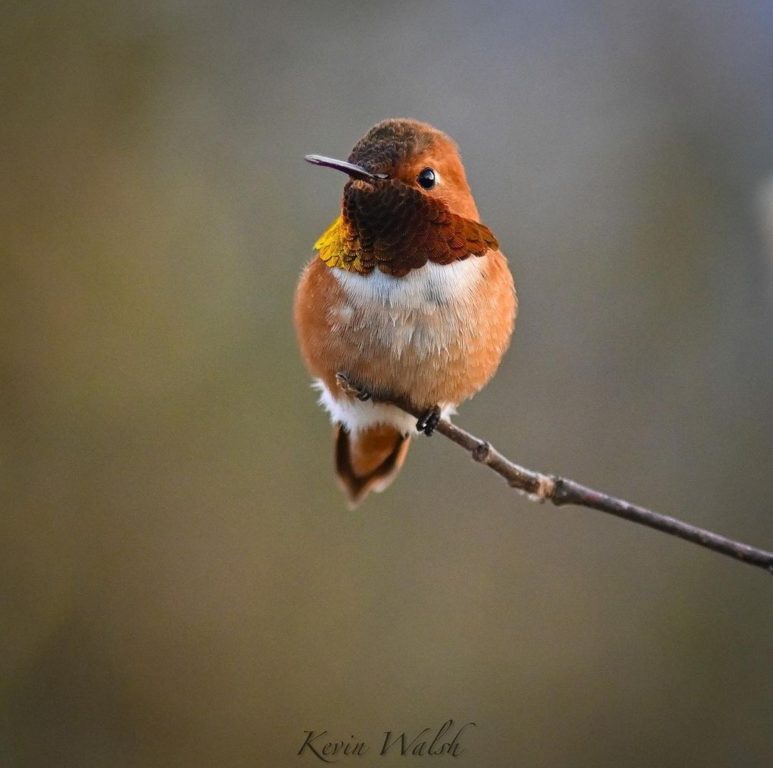
Photo by: Kevin Walsh
Anna’s hummingbirds are more likely to stay year-round in the northern hemisphere and not migrate south for the winter.
To aid the non-migratory hummingbird population, here are a few tips to help these winter guests thrive:
Feeder Placement
Hang and position the hummingbird feeders in a sheltered location. Safeguarding and protecting the feeders against wind exposure prevents the hummingbird nectar from freezing as quickly.
Placing the feeders under a covered porch or on the downwind side near a tree, shed, or side of the house protects both the hummingbird and the feeder from being vulnerable while creating less exposure to elements such as wind, snow, and ice.
Hummingbirds cannot access ports on frozen hummingbird feeders, which is the first area of freezing on the feeders.
Bring Feeders In At Night
A nightly routine practice of bringing hummingbird feeders in after the sun sets prevents the sugar water nectar from freezing.
Place the feeders inside at night to warm them up using the ambient temperature of the house getting them ready for the morning feeding activity.
Keep Nectar From Freezing
There are multiple ways to keep your hummingbird nectar warm and from freezing.
Attach a heated electronic hummingbird feeder to the base of a saucer-only style feeder. There are companies that use thermostatically controlled heaters for specific hummingbird feeders. They are best used near protected or sheltered walls, with electrical outlets that are weatherproofed and away from the elements.
Lamps or shop lights clamped to hanging adjacent hummingbird feeders have the ability to keep hummingbird feeder nectar from freezing if it has the correct light bulb wattage and is hung at an appropriate distance from the feeder.
Choose a light bulb with a sufficient wattage rating to produce ambient heat but not so hot that it would be beyond the hummingbird’s tolerance. Obtaining this ambient temperature can be further controlled by the distance between the light source and the hummingbird feeder.
Activating and attaching hand warmers to the feeder is an inexpensive way to keep your nectar from freezing and provides mild heat.
These hand warmers can be attached to the hummingbird feeders with pipe insulators or elastic tubular sleeves.

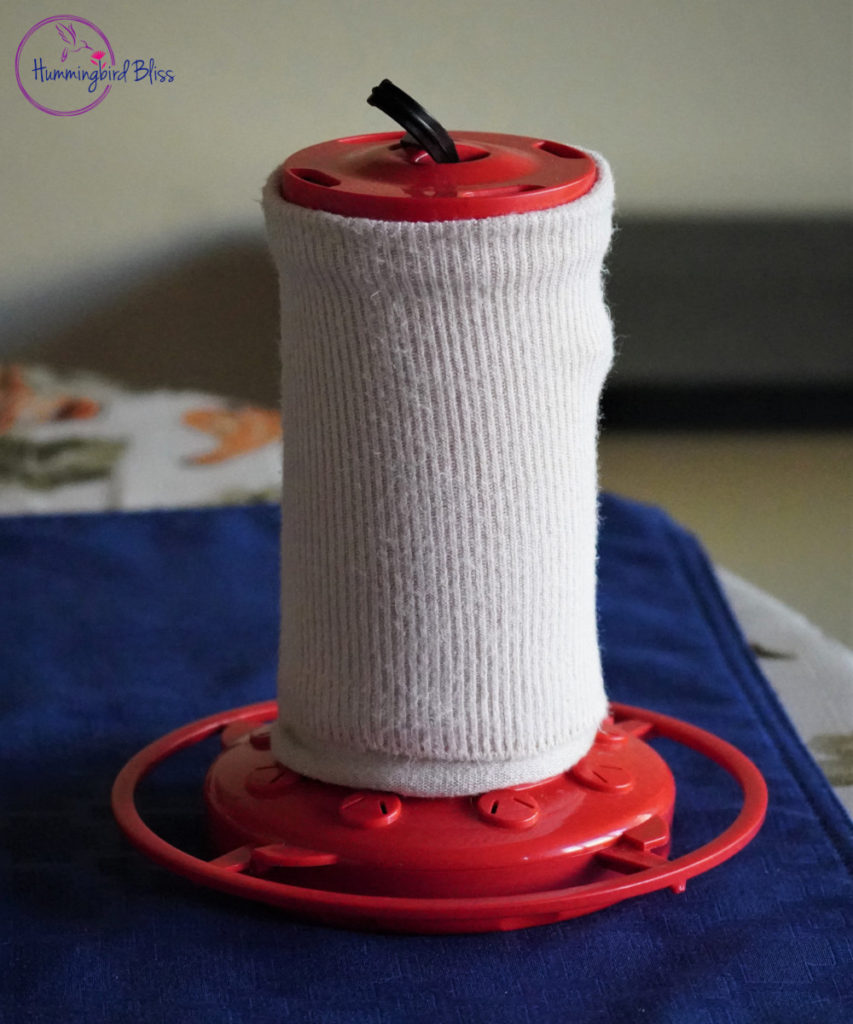
Surround a feeder with holiday lights for gentle heat by using timed outdoor NON-LED lights. The low voltage high-efficiency LED lights do not produce enough heat to warm feeder nectar. Remember to weatherproof the ends with electrical tape.
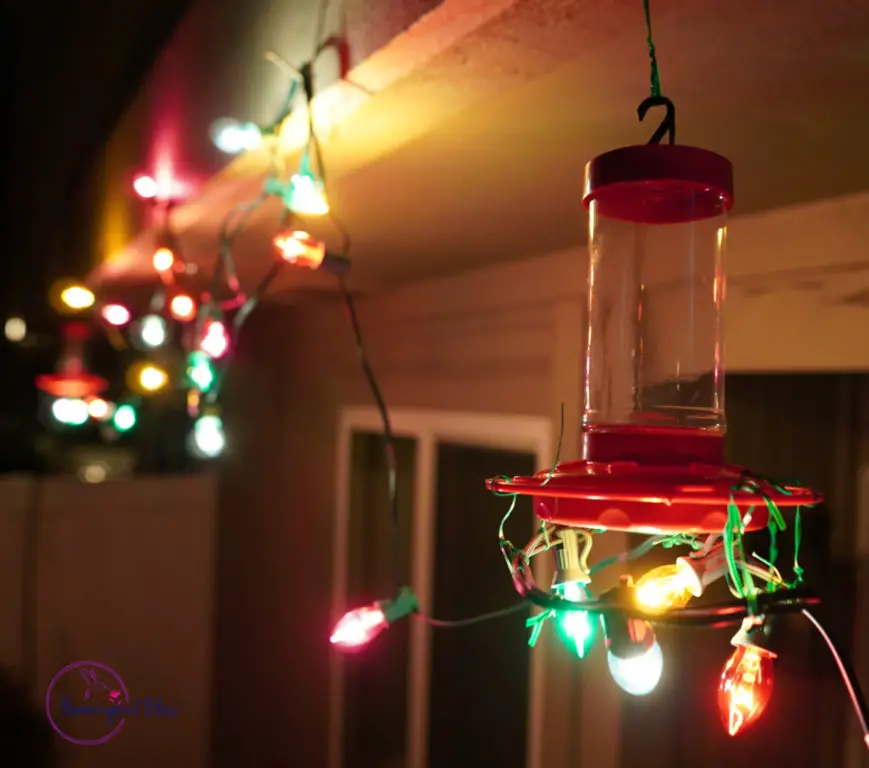
Insulate the Feeders
Insulate your feeders by using flexible foam pipe, oven mitts, an old sock, knit an insulation cover, or use bubble wrap. Using all or a combination of these insulation ideas will help to protect and keep the sugar water from freezing against the elements.

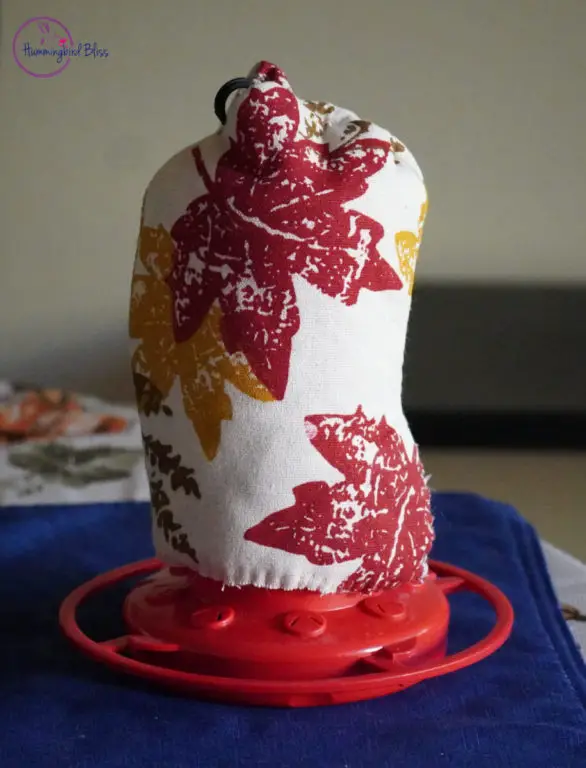
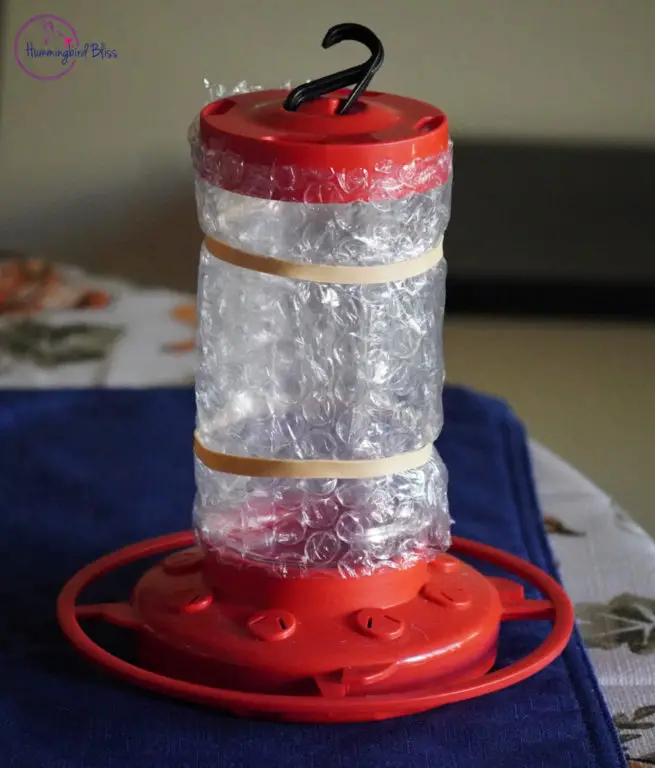
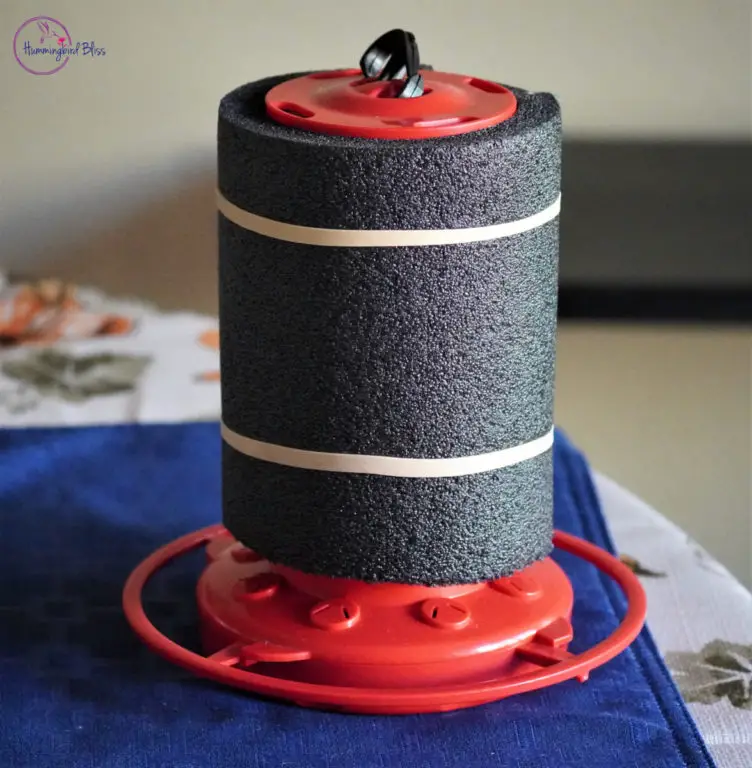
Rotate the Feeders
Rotate feeders to keep an available reserve of unfrozen hummingbird nectar ready and accessible multiple times a day. The liquid sugar water nectar is crucial for hummingbird survival, especially during the colder weather.
Warm nectar in feeders to the house’s ambient temperature during the day, and alternate them with the outdoor hummingbird feeders.
This will require twice the number of feeders as needed during the summer, half outside and half inside.
I use two different kinds of feeders, plastic feeders and glass feeders.
Snow Baffle Domes
Covered hummingbird feeders with overhead snow baffles are helpful for shielding the hummingbird feeder from precipitation such as rain, snow, sleet, and ice. Such devices must have a large enough diameter to cover the top of the hummingbird feeder and extend beyond the feeder ports to prevent clogged or frozen ports.
Clean Feeders
Feeder maintenance is always important for hygiene all year round no matter the fluctuations in temperature. Providing unclogged feeder ports from snow and ice helps the hummingbird to have access to liquid nectar.
Regularly changing the nectar solution and cleaning the feeder, especially during the winter, helps to keep free-flowing liquid nectar available for hummingbird consumption.
There is no exact answer on how often to change hummingbird nectar during the winter. The main goal is to provide unclogged ports on the feeder with liquid nectar that is not frozen.
At near but not freezing temperatures, sugar water should be viable for 5 -7 days. This is the consensus for the length of time you can keep sugar water in a refrigerator whose temperature is usually in the range of 38-42 degrees Fahrenheit.
Hummingbirds that choose to be year-round residents rely heavily on available clean feeders away from harsh outside elements in order to survive the rough winters.
Maintaining feeders through strategic placement, supplementary warmth, and diligent hygiene proves advantageous for hummingbirds where food supply is scarce. Preservation of suitable feeding conditions is pivotal for resilient hummingbirds and winter survival, especially during periods of plummeting temperatures and gusty winds.
For more information on commercial vs. homemade hummingbird nectar, read my article: Forget Commercial Hummingbird Food: Try Making Homemade Nectar.
Some hummingbird enthusiasts suggest using a higher concentration of nectar solution (1:3) sugar to water ratio instead of the regular 1:4 ratio for hummingbirds during the colder winter months to assist with more calories since their energy expenditure and metabolism are high. Even though this solution will slow the process of freezing, many believe the 1:3 ratio is not suitable and will cause hummingbirds to have digestive issues.
Will Hummingbirds Drink Cold Sugar Water?
Hummingbirds will drink cold sugar water at ambient temperatures. The hummingbird’s body needs to warm the cold nectar straining its energy resources as it prompts higher metabolic rates. Nectar at an ambient temperature supports their vitality and optimal functioning.
When cold weather drops to below-freezing temperatures it will affect hummingbirds drinking cold sugar nectar. Hummingbirds are less worried about the temperature of their nectar source being too cold and are more concerned with feeding their rapid metabolism and boosting their vitality.
The sugar-to-water nectar ratio of 1:4 in hummingbird feeders can get as cold as 26-27 degrees Fahrenheit (-3.33 degrees to -2.78 degrees Celsius) when left outside in sub-freezing temperatures. That’s pretty chilly!
An article on ebird.org mentions that hummingbirds have been seen in temperatures as low as -9 degrees Fahrenheit actual, and a wind chill factor of -36 degrees Fahrenheit.
28 degrees Fahrenheit.
There are some experts such as Audubon.org that claim hummingbirds who drink cold nectar on a cold day could get hypothermia or even “cold-stunned,” suggesting a mini-brain freeze.
Counterarguments suggest that there is not enough solid proof to show that cold nectar directly leads to hummingbird hypothermia.
A study was conducted with hummingbirds who were given two temperatures of sugar nectar, one at 102.2 degrees Fahrenheit (39 degrees Celsius) and the other extreme at 39 degrees Fahrenheit (4 degrees Celsius).
The hummingbirds that sipped the cold nectar had to work extra hard to warm it up inside their bodies, thus draining their energy. These are not ideal situations for hummingbirds especially during cold sub-freezing temperatures, yet they manage to cope with their environmental surroundings and consume cold sugar water if it is the only available food source.
While they can handle cold nectar, they prefer their nectar to be of ambient or current body temperature.
What Do Hummingbirds Eat in the Winter?
In the winter, hummingbirds eat nectar from winter-blooming flowering plants and homemade feeder nectar for carbohydrate energy. They also eat insects and spiders for protein tissue maintenance, growth, and development, and some protein is actually converted to energy as needed.
Hummingbirds rely on urban gardens with nectar-producing wintering flowers, insects for protein, and supplemental feeders with homemade nectar throughout the year, especially during the winter season.
Winter-flowering nectar-producing plants are listed below in order of cold tolerance:
- Mahonias (Mahonia x media)
- Witch hazels (Hamamelis)
- Grevillea Victoriae
- Winter Honeysuckle (Lonicera fragrantissima)
- Winter Jasmine (Jasminum nudiflorum)
- Hellebore
- Winter Heather
- Camellia
- Cape Honeysuckle
- Blue Gum Eucalyptus.
These plants’ precise blooming times can change depending on the region, environment, and species, among other things. To identify the finest selections for your area and preferences, consult local gardening guides or nurseries.
While hummingbirds are primarily nectar consumers, they also diversify their diet with insects and spiders for protein during winter scarcity.
Anytime during the year, consuming insects is an additional and valuable source of protein for hummingbirds. Insects are generally less active during the winter months due to the colder temperatures. However, attracting insects for hummingbirds, with manure or other organic materials can be accomplished even in cold weather.
Manure provides a source of nutrients and warmth for these insects, which can be beneficial for the decomposition processes.
Decomposition stops entirely when the components in a compost pile are completely frozen, however, if you have a sizable compost pile or bin, it is possible that the center organic material will keep warm enough to prevent freezing and that decomposition will continue even in the winter.
Remember the types of insects that appear will depend on the location, the type of manure, and other environmental factors.
Below is a list of 15 insects, listed in order of frequency eaten by hummingbirds in the winter:
- Aphids
- Gnats
- Fruit Flies
- Midges
- Small Moths
- Leafhoppers
- Ants
- Spider Mites
- Scale Insects
- Springtails
- Psyllids
- Small Flies
- Beetle Larvae
- Termites
- Mosquito
Interestingly while mosquitos are one of the most popular things for hummingbirds to eat, they are the least likely to be present in cold weather.
It is important to note that this list can vary based on geographic location and availability.
What Nectar-Producing Plants Flower in the Winter?
Winter nectar-producing flowering plants that hummingbirds may visit, listed in order of cold tolerance include:
- Mahonias (Mahonia x media)
- Witch hazels (Hamamelis)
- Grevillea victoriae
- Winter Honeysuckle (Lonicera fragrantissima)
- Winter Jasmine (Jasminum nudiflorum)
- Hellebore
- Winter Heather
- Camellia
- Cape Honeysuckle
- Blue Gum Eucalyptus
The phenomenon of hummingbirds enduring winter conditions showcases their unique adaptation. Winter and early spring can be tough for hummingbirds to locate natural flower-produced nectar since they need an abundant amount of energy to keep warm.
Hummingbirds have acclimated to urban environments, where nectar-bearing winter plants enable them to choose to be year-round residents.
Below is more information about each individual cold tolerant plant and what USDA Hardiness Zones are best for them:
Mahonias
USDA Hardiness Zones 6 to 9.
Mahonias (Mahonia x media) are a group of hybrid evergreen shrubs that are popular in gardens for their striking foliage, vibrant flowers, and adaptability to various growing conditions.
These plants are the result of crossing Mahonia lomariifolia and Mahonia japonica. They are known for their architectural structure and ability to thrive in both shaded and partially shaded areas.
Mahonia plants produce small, fragrant, brightly colored, winter-blooming flowers that contain rich nectar, which is a valuable source of energy for hummingbirds. Clusters of bright yellow flowers form at the tips of the branches. These flowers provide a burst of color during the colder months, attracting pollinators and adding interest to the garden.
Mahonia species like Mahonia aquifolium (Oregon grape) and Mahonia nervosa are among those that are frequently visited by hummingbirds for nectar.
Witch hazels
USDA Hardiness Zones 5 to 8.
Witch hazels (Hamamelis vernalis), a species of flowering shrub native to Asia and the Southeast United States, have been cultivated for both their decorative and therapeutic qualities.
These plants are well known for their fragrant, distinctly shaped flowers, which have thin petals that resemble ribbons and fold and twist like spider legs. Depending on the species or cultivar, the blossoms appear in yellow, orange, or red hues.
Witch hazel blooms during the late winter to early spring, typically from December to March, before their leaves emerge. Their flowers bloom during the colder months when few other plants are flowering.
Grevillea victoriae
USDA Hardiness is Zone 7.
Grevillea victoriae, commonly known as the “Royal Grevillea” or “Mountain Grevillea,” is a flowering shrub belonging to the Proteaceae family. This family is mainly found in southeastern Australia, particularly the mountainous regions of New South Wales and Victoria.
At the extremities of branches, the blooms are typically grouped in dense clusters to create striking inflorescences. The unique flowers each have a long, curving style that distinguishes them from one another. The shape of the flowers and the high nectar content make them well-suited for hummingbirds to feed from using their specialized long bills and tongues.
The blossoms can range in color from red, pink, or orange undertones. Because they are nectar-rich, they draw local birds, insects, and hummingbirds.
The blooming season starts in early autumn through winter.
Winter Honeysuckle
With a USDA Hardiness Zone range of 4–8, they can withstand winter temperatures as low as -30°F (-34°C).
Winter honeysuckle (Lonicera fragrantissima) is a deciduous shrub known for its delightful fragrance and early blooming flowers. It is a member of the honeysuckle family (Caprifoliaceae) and is native to China.
The plant blooms in late winter to early spring, often starting in late January or February and continuing into March.
The flowers are small, creamy white or pale yellow, and tubular in shape. They are born in pairs or clusters along the stems.
Winter honeysuckles are able to bloom during the cooler months when few other plants are blooming.
Winter Jasmine
USDA Hardiness Zones are 6 to 10.
Winter jasmine (Jasminum nudiflorum) is a deciduous flowering shrub that is native to China. It belongs to the olive family (Oleaceae) and is popularly cultivated in gardens for its cheerful display of color when most other plants are dormant
The Winter jasmine is renowned for its bright vibrant yellow blooms that appear during the late winter months and early spring, providing a burst of color to the winter landscape.
Hellebores
The Ranunculaceae family includes a variety of perennial flowering plants known as hellebores, commonly referred to as Lenten roses or Christmas roses. They are indigenous to Europe and some regions of Asia, and are increasingly common ornamental plants in gardens all around the world.
Hellebores are highly valued for their early long-lasting blooms and evergreen foliage. They often blossom when other plants are still dormant, in late winter and early spring. They can begin blooming as early as December and continue into April, adding much-needed color and interest to the garden during the colder months.
It is important to note that hellebores contain compounds that can be toxic if ingested and it is advisable to handle these plants with care and keep them out of reach of children and pets.
Winter Heather
USDA Hardiness Zones are 5 to 7.
Winter heather, also known as Erica carnea, is a hardy and attractive flowering plant indigenous to Europe’s mountainous regions. It belongs to the Ericaceae family.
The blooming period starts from late fall in November to early spring all the way through March or April, when most other plants are dormant. Winter heather is a popular choice for bringing color and texture to gardens throughout the colder months.
It can tolerate frost and even light snow adding wonderful color to winter gardens.
Camellia
USDA Hardiness Zones are 7 to 9.
Native to eastern and southern Asia, mainly Japan, China, and Southeast Asia, camellia plants are members of the Theaceae family. They are well-liked as garden plants, particularly in areas that are temperate and subtropical.
Shades of white, pink, red, and even yellow can be seen in the huge, spectacular flowers that are grouped in an orderly arrangement. Depending on the species and location, the flowering season might vary, but it typically lasts from late October to early April.
Cape Honeysuckle
USDA Hardiness Zones are 9 to 11.
Cape honeysuckle (Tecomaria capensis), also known as firecracker plant or just honeysuckle, is a popular invasive flowering shrub or climbing vine native to South Africa. It is widely cultivated in many parts of the world for its vibrant and showy flowers, which resemble those of true honeysuckle plants (Lonicera species) and attract pollinators like bees, butterflies, and hummingbirds.
The plant produces clusters of tubular, trumpet-shaped flowers that come in shades of orange, red, or coral. The flowers are highly attractive and provide a burst of color in gardens and landscapes. They are known for their resemblance to traditional honeysuckle flowers, although the two plants are not botanically related.
Cape honeysuckle usually blooms prolifically during the warmer months, particularly in spring and summer, however are also known to bloom from fall to spring when receiving full sun.
Blue Gum Eucalyptus
USDA Hardiness Zones are 8 to 11.
Blue Gum Eucalyptus, scientifically known as Eucalyptus globulus, is a tall and iconic invasive evergreen tree native to Australia. It belongs to the family Myrtaceae and is renowned for its distinctive appearance, fast growth, and aromatic properties.
This non-native tree has expanded its range northward along the west coast, providing hummingbirds with a newfound food source during the winter.
The Blue Gum Eucalyptus produces clusters of small white flowers. These flowers are full of nectar and attract various pollinators, including bees, butterflies, and hummingbirds.
During the wet season, the Blue Gum Eucalyptus blooms from November to April.
Cultivating cold-season nectar-producing plants and early spring preparation is vital for those hummingbirds that chose to overwinter in place instead of migrating south.
Urban landscapes can provide a dynamic winter food source, creating hummingbirds to discover non-migratory and over-wintering habitats. Urban development has unintentionally played a role in their newfound ability to brave the winter months.
Check with your local nursery to see what nectar-producing hummingbird-friendly plants will survive in your winter conditions.
Check out my other posts on Hummingbird Questions
Stay Warm
Happy Winter Hummingbird Watching!
Backyard Visitors participates in affiliate programs which compensate us for referring traffic.

